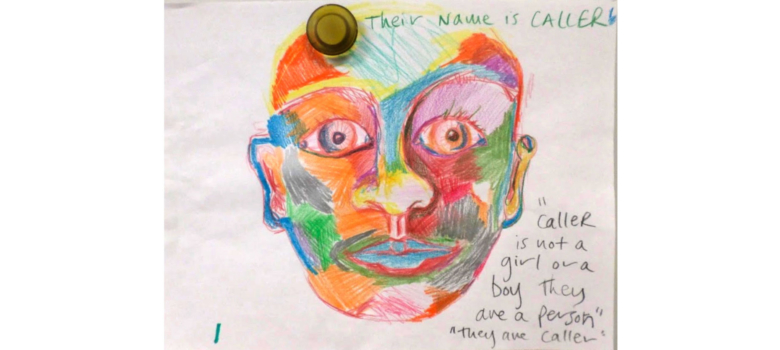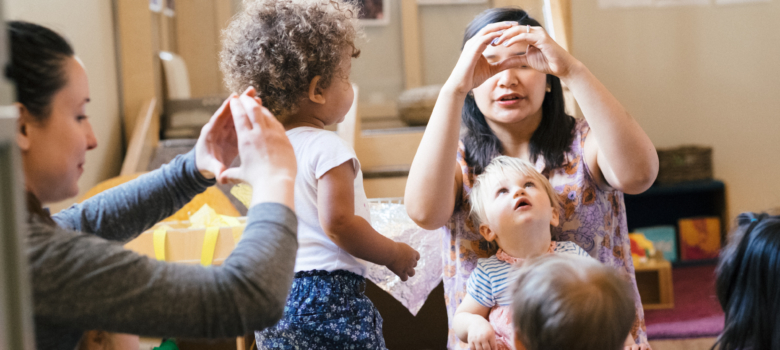by Maia Brown, Infant-Toddler Education Teacher
When I draw, I often find myself drawing faces. Most children I have taught know this about me. We sit together exploring art materials in the morning or as children slowly wake up from nap in the afternoon, and sometimes a face will grow on the page in front of me. We ask each other questions about the marks we make, the images that we create. Is there a story in what you are making? is often part of what we are asking. We create meaning together as we draw and inquire of each other—wondering together about what we are making and why. One particular day, a number of years ago, was like that. Neila, Yasmin—both four years old—and I were drawing (children’s names have been changed for privacy).
Neila: “Teacher Maia likes to draw faces”
Yasmin: “What are you drawing?”
Maia: “I don’t know.”
Neila: “She doesn’t know yet, she doesn’t know when she starts.”
It did, indeed turn into a face, all patchworks of wild colors that both children began to help me with. We kept working on it, passing it back and forth amongst us. Then Neila asked, “Is it a boy or a girl?” This had become a common question. A classroom of four- and five-year-olds are interested in making distinctions, noticing patterns, playing roles. The answer I gave I had given before, but for whatever reason we were all ready to dig deeper into the question together.
Maia: “Oh. This is not a girl or a boy.”
Neila: “So what is he?”
Maia: “If this person is not a girl or a boy, why say he?”
Neila: “What is she? …oh…”
We all stopped to notice for a moment that we had stepped out of a binary and were looking around and getting our bearings. After a pause, I offered, “Here is something I know that might be helpful. If someone is not a girl or a boy you can say they.”
Neila: “They are not a boy or a girl, they are just a person?”
Maia: “Yeah! Would it help if they had a name and we knew some things about them?”
Neila: “Yes!”
Maia: “What is their name?”
Neila: “His name is Caller.”
Maia: “His?”
Neila: “THEIR name is Caller. Woah, this is hard.”
Maia: “Yeah. It is hard to learn and remember but I think we can do it.”
Yasmin: “Caller is not a boy or a girl. Caller is Caller.”
As we imagined, this is what we discovered about Caller: “Caller lives in a house, but it is sturdy. They play duck, duck, goose and they play puzzles and board games and they draw. They paint and they have a few money and they can read books. They can play soccer, football, and basketball–all the ball games in the world!”
We introduced Caller to the rest of the class briefly at Circle the next day and they lived on our whiteboard in the classroom all year long becoming one of many non-binary characters in the recurring stories we told together. Soon after Caller joined our classroom imagination, Ariel, my co-teacher for many years after, joined our classroom community. Ariel uses they/them pronouns and began telling Princet Ayo and Princess Fish Stick stories, introducing Princet as a non-binary royal title. We loved those stories! The fluidity and expansiveness of gender became familiar in our play and storytelling. We had language for it and many different relationships to it as we moved through our days together. Students often corrected their parents gently throughout the year, “Ariel is not a boy or a girl, they are non-binary.”
Caller was something that happened in between “what we were doing” that day. That is what made it possible, I think. What happened was the co-creation of a developmentally appropriate entry point for an exploration of gender in our classroom. It was rooted in our relationship to one another, and to the small everyday rituals of our time together: of drawing together and the closeness and openness we felt in those interstitial moments. Often, those are the moments that make up our best learning and create the fabric of how we allow each other to think about and understand the world.
It is noticing the decisions we make in the small quotidian moments that allows us to normalize queerness and the myriad of gender identities that children can experience. Some of us call this attention modeling, or broadcasting, or emergent teaching and learning, or cultivating school culture. It is all of these things, I think. It’s how we tell stories and who are in our stories, how we play with children and offer extensions to their explorations. We tell stories every day in our classrooms—the ones we notice and the ones we don’t. How we move through the day, our tone, our energy and focus, where we devote our attentions all tell stories to children about what is possible, what is real, what is important, what is beautiful or harmful, what is valued.


